Behold! A gateway to your own past if you wish. All that you knew has been altered.

May 1957: the Brooklyn Dodgers and New York Giants receive permission to move their franchises to the West Coast. One of the Giants’ board members, Wall Street broker M. Donald Grant feels strongly that the Giants belong in New York.
Summer 1957: Grant convinces the rest of the Giants board to take a look at a proposal from Robert Moses, calling for a new stadium in Flushing Meadows Park. With an offer on the table from San Francisco, the Giants play high stakes poker.
September 1957: It is clear that the Dodgers are heading west. Mayor Robert Wagner convenes a committee of “sports minded businessmen” to keep the Giants from also fleeing. At the 11th hour a deal gets done, and the Giants will be playing in New York in a new stadium in Queens in 1961.
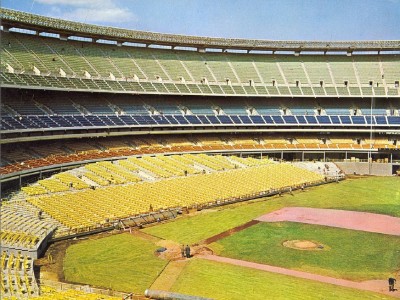
1961: The Giants move into their new home, Giants Stadium, on Roosevelt Avenue in Queens. Despite the allure of the new park, the Giants are outdrawn by Mantle, Maris and the 1961 Yankees. Giants Stadium also becomes home to the AFL’s Titans.
Meanwhile, Major League Baseball has a new shape as the American League expands into San Francisco and Minnesota. The expansion San Francisco Seals are one of baseball’s all-time worst teams finishing 42-120 in the new 162 game schedule.

1962: The National League expands into Houston and Toronto. Bob Murphy joins the Giants broadcasting team, working as a team with Russ Hodges and Lon Simmons until 1971. Murphy will stay with the Giants for the rest of his career and become the voice of the Giants to many young fans growing up in New York.
The Giants win the pennant and play the Yankees in the Subway Series, but the Yankees come out on top.
However,the Yankees dynasty ends in 1964, Yogi Berra is dismissed by the Yankees, and by the end of the decade the Yankees are playing to sparse crowds in the Bronx. The Giants have good seasons, just missing the playoffs several times winning 90 games several times.
1966: The Seals win the rights to pitcher Tom Seaver after a complicated lottery and near lawsuit. The kid from Fresno is thrilled to be playing in Northern California, albeit for the hapless Seals.
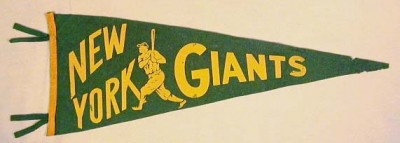
1969: Baseball expands again, with Montreal and San Diego joining the American League, and Kansas City and Seattle joining the National League.
93 wins is enough to take the newly formed NL East, and the Giants are aided by beating up on the new expansion Kansas City Royals. The Giants easily dispose of the Braves in the NLCS, but the Seals are a team of destiny, taking out the powerful Orioles in a 5 game ALCS before beating the Giants in a 7 game World Series.
Up 3 games to 2, Seals manager Yogi Berra almost gives the series away by starting Tom Seaver on short rest in Game 6, but Jerry Koosman bests Juan Marichal in an epic game 7.
Man has landed on the moon, and the Seals have won the World Series.
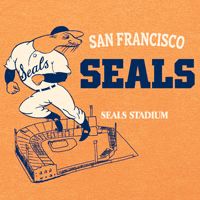
1971: 90 wins is not enough as the Pirates make it clear they are now the team to beat in the NL East.
1972: Willie Mays announces that he will retire at the end of the 1973 season. Much of the Giants’ marketing is around a Mays farewell tour, which hides a 69 win disaster.
1973: the NL East can’t get out of its own way. Although 88 wins would only have been good enough for third place in the NL West, the Giants easily win the east. The Giants are no match for the Big Red Machine in the playoffs, and many Giants fans are left with the memory of Willie Mays stumbling in the outfield during the NLCS.
1974: The Giants honor the 1954 club with special patches. The broadcast booth is named the Russ Hodges Broadcast Booth in his honor.
1975: while Yankee Stadium is being rebuilt, Giants Stadium is home to four professional sports teams: the Giants, the Yankees, the Titans and the Football Giants, who for one year will call their home Giants Stadium. The football club eventually winds up in Meadowlands Stadium, and will be joined by the Titans a decade later.
1976: Owner Horace Stoneham is struggling to keep the Giants afloat and sells the team to an ownership group led by Nelson Doubleday and Fred Wilpon.

1977: The new owners introduce new uniforms. The Giants move away from their traditional block lettering and opt for a script Giants. The team wins 75 games. Things are not off to a good start for Doubleday and Wilpon.
June 15, 1977 – “The Trade”: Meanwhile, across town the Yankees are on their way to winning the first of two World Series led by Mr. October. In an effort to make a big splash, the Giants trade four young players to San Francisco for Tom Seaver. Fans are irate that the Giants have mortgaged the future for the aging pitcher. This moment goes down as “The Trade” and is still talked about 40 years later.
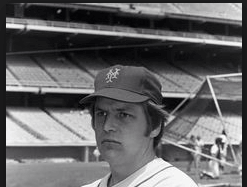
For the most part, the 1970s are lean years for the Giants. Seaver is solid enough, but his 10 win season in 1980 makes him a lightning rod for all that is wrong in Queens. It is an ugly five years in exile for the man San Franciscans call The Franchise.
1980s: the 1980s are no better for the Giants. Fans hang their hopes on young star Will Clark.
1983: During the off-season, the Giants finally part ways with Seaver, sending him back to the Seals. Later that year, the Seals also make a mid-season trade for Keith Hernandez. Hernandez is excited to return to the city in which he grew up, eventually becoming the Seals’ captain and now one of the team’s long time broadcasters.
1984: The Giants honor the 1954 club with special uniform patches.
1986: The Giants win 83 games, the first time they finish above .500 since The Trade. The all-time Giants villain Tom Seaver ends his career as part of the World Champion Boston Red Sox. Of course he does, that seems to be the luck of the Giants fan. It has been a long decade in Queens.
1992: The “Will Clark episode” of Seinfeld airs. Giants ownership signs free agent Barry Bonds, which finally brings new energy to Giants Stadium after 15 years of awful baseball.
1993: The Giants win 103 games but are eliminated in the playoffs by the Braves. Many “long time Giants fans” return from their 15 year sabbatical in the Bronx.
1994: The Giants honor the 1954 club with special uniform patches.
1997: The Giants introduce a blue alternate uniform set, infuriating older fans who can’t stand the sight of the Giants wearing the royal blue of the Brooklyn Dodgers. Younger fans love the blue look and it becomes a top seller, and despite being an alternate jersey, the Giants tend to wear the blue almost exclsuively.
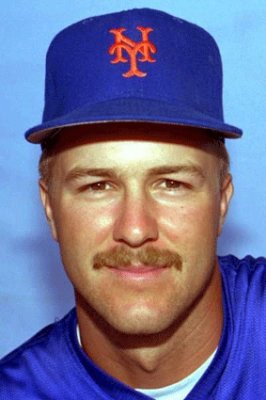
1998: Fan favorite Jeff Kent joins Bonds in the Giants lineup. It is the summer of the Home Run as Mark McGwire and Sammy Sosa reach new heights on the home run charts. In the NFL, the Tennessee Oilers change their nickname to the Tennessee Pioneers.

2000: The Giants and Yankees meet in the first Subway Series since the 1960s. The Yankees take the series in 5 games.
October 2001: with the city reeling following 9/11, Bonds gives New Yorkers something to smile about as he breaks Mark McGwire’s home run record. Home Run #71 is still referred to as “the Bonds home run” and many fans commemorate the anniversary every year. The Giants fall just short of making the post-season.
2002: Bonds wins the MVP, and Kent has another big year and the Giants win yet another pennant. However, the American League champion Expos are too much, and the Giants are once more bridesmaids.
2003: The Giants outpace the Florida Marlins, head to the World Series, and once again face a familiar foe in the Yankees. The Yankees take the series in five games, giving the Yankees their fifth championship since 1996. Giants fans are getting frustrated again, but they don’t know how bad things are to become.
2004: The Giants honor the 50th anniversary of the 1954 club with ceremonies and special uniform patches.
2005: The Giants begin to talk about replacing aging Giants Stadium. One leaked design suggests the new park might look like the old Ebbetts Field. It turns out owner Fred Wilpon was a Dodgers fan not a Giants fan growing up. After being destroyed on sports radio, the Giants quietly alter the design.
Later there is talk of the new park honoring Jackie Robinson, but again Giants fans are irritated that ownership would want to honor the Dodgers, especially a man who decided he would rather retire than be a Giant.
2006: SNY signs on the air. Gary Cohen, Will Clark and Mike Krukow form a well respected booth. Former Giants Extra host Howie Rose becomes the main radio voice of the Giants.
2007: Barry Bonds passes Hank Aaron to become baseball’s Home Run King. SNY sees record ratings.
September 22, 2007: At a bizarre press conference, the Giants announce they will not be re-signing Barry Bonds, stressing the need for youth and speed. Giants fans call the owners stupid and cheap.
2008: Giants Stadium closes with a tremendous ceremony honoring the team’s past.
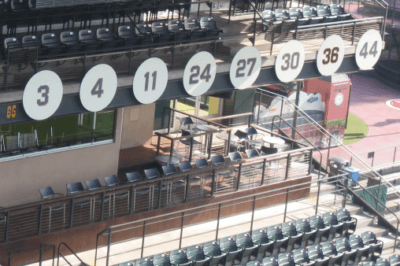
2009: Citi Field opens on the site of the old Giants Stadium parking lot. The centerpiece is the Willie Mays Rotunda, which celebrates over 100 years of New York Giants history. Fans are frustrated with the team’s constant focus on past glories and complain to sports radio hosts that maybe the Giants should have spent money on players instead of statues of Christy Mathewson and John McGraw.
2010: Popular blog Uni Watch starts a “Ditch The Blue” campaign, encouraging the Giants to stop wearing their blue alts all the time and return to the traditional black and orange.
The Giants look like they could make a run, but the team is financially strapped and has to take a loan from Major League Baseball. 2011 is a disaster. The 2012 club shows signs of life but once again General Manager Sandy Alderson does not have the resources to make any impactful roster moves.
2014: The Giants focus on honoring the 1954 club’s 60th anniversary and have indeed Ditched The Blue, restoring the traditional black and orange uniforms including the block lettering. Older fans are pleased, younger fans just want to win. However, with the team financially strapped by the Madoff situation, the mid 2010’s are not a good time for Giants fans….all they have is a team and ownership that wants to celebrate the past.
Time has resumed its shape. All is as it was before. Many such journeys are possible….let me be your guide.
